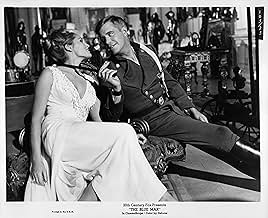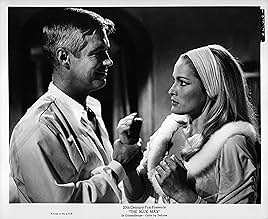Ajouter une intrigue dans votre langueA young pilot in the German air force of 1918, disliked as lower-class and unchivalrous, tries ambitiously to earn the medal offered for 20 kills.A young pilot in the German air force of 1918, disliked as lower-class and unchivalrous, tries ambitiously to earn the medal offered for 20 kills.A young pilot in the German air force of 1918, disliked as lower-class and unchivalrous, tries ambitiously to earn the medal offered for 20 kills.
- Victoire aux 1 BAFTA Award
- 1 victoire et 5 nominations au total
- Elfi Heidemann
- (as Loni Von Friedl)
- Feldmarschall von Lenndorf
- (as Friedrich Ledebur)
Histoire
Le saviez-vous
- AnecdotesFox wasn't able to rent any of he surviving WWI planes still extant, so they built their own. The aircraft were later used in "Darling Lily" and "You Can't Win Them All."
- GaffesThe German award called the "Pour le Mérite" (a.k.a. the Blue Max) was awarded at the beginning of the war to pilots who shot down 8 enemy aircraft; that was later raised to 16. The requirement was never 20 as depicted here.
- Citations
Willi von Klugermann: By the way, Stachel... there's an impression around that... you care more about your unconfirmed kill than you do about Fabian's death.
[long pause]
Bruno Stachel: Perhaps it's force of habit. In the trenches, we couldn't even bury the dead; there were too many of them. I've never had the time... to discuss them over a glass of champagne.
- Versions alternativesIt is believed that this film was at one time released in a 70 mm version (because of its six channel soundtrack), but this has never been confirmed.
- ConnexionsFeatured in The Amazing Howard Hughes (1977)
- Bandes originalesDeutschlandlied
(uncredited)
Music by Joseph Haydn
Lyrics by August Heinrich Hoffman von Fallersleben
Played at Stachel's medal presentation
Unmistakably one of the most entertaining war films to come out of the 1960s, "The Blue Max" is the kind of film that could only have been made in Hollywood. Featuring some of the best aerial combat scenes ever shot and a great ensemble cast, it's enjoyable pulp fantasy for any war film fan.
The film opens with a brilliant, intense action sequence: Bruno Stachel (George Peppard, "Tobruk") dives into a mud-filled crater on the Western Front. He's visibly exhausted; his heavy breathing and unshaven face reveal how horrible front line conditions are. From above comes the sound of a dogfight Peppard's bright blue eyes blare from a mud-covered face as he stares in awe at the action in the skies above him, the mood fully established with Jerry Goldsmith's evocative score. Flash forward two years: Stachel has transferred to the Luftwaffe and is a green, inexperienced pilot. A peasant, Stachel has little in common with his high-class comrades, members of the elite Officer Corps. He's ruthless and ambitious, and sets his sight on winning a Blue Max the medal awarded to a pilot with 20 kills to his credit. With this award, Bruno will have won the respect of his comrades. Squadron commander Heidemann (Karl Michael Vogler, "Patton") has one, and hotshot Willi von Klugermann (Jeremy Kemp, "Operation Crossbow") is awarded one early in the film. Stachel vigorously has to catch up to their status, and Willi takes a liking to him, helping him try to fit in.
As Germany is losing the war, Willi's uncle, General von Klugermann (James Mason, "Cross of Iron") enters the stage: he sees potential in Stachel for more than just flying prowess. This is a time when the common people of Germany need a hero. Stachel is a poor farm boy, someone they can all relate to. Von Klugermann sets out to make Stachel a national icon; when he received a minor wound, he's escorted to a cushy Berlin hotel and the press takes pictures of a nurse tending to his wound, plastering pictures all over the national newspapers. Countess Kaeti von Klugermann (the beautiful Ursula Andress) sets her sights on Stachel, and soon a steamy affair has begun, right under the nose of the General. As Stachel's selfish ambitions become more apparent and blatant, Willi's friendly competitiveness fades and their adversity becomes an all-out battle. All of this builds to an unavoidable, somewhat depressing ending.
This is a character-driven drama firstly, and the action is simply a supplement to the story of the characters. Unfortunately, Peppard is a wooden lead. He speaks in unaccented English and never seems to be thoroughly involved in his part; it's as though he's sleepwalking through almost every scene. The rest of the cast deserves more credit. Co-star Jeremy Kemp is much more believable. He's sly, cynical and delivers fantastic deadpan humor. James Mason is brilliant as usual as General von Klugermann, a career German officer whose chief concern is for the German people and his nation's prestige. I have never seen Mason deliver a bad performance, and here he is simply fantastic. He's often cool and restrained, but lets anger and rage come out full-force at key moments. As his unfaithful wife, Ursula Andress is her typical self; beautiful and often barely concealed. A standout is Karl Michael Vogler as Heidemann. A veteran flyer devoted to his duty, Heidemann is a career soldier. He's been fighting since the beginning of the war, and although weary and tired, keeps doing his job. His chief goals are keeping as many planes flying as possible, despite Allied air attacks and supply shortages. He demands that Stachel's ambitions take second fiddle to strategic operations; when he disobeys orders, Heidemann threatens to have him court-martialed. Vogler's performance is excellent, and he walks away with each of his scenes.
Director John Guillermin and Director-of-Photography Douglas Slocombe weave some excellent flying sequences into the film's story. These action scenes are not independent conflicts between German and English fighters conflicts between characters are developed on the ground and either expanded or settled in the air. The skies have never been bluer, and the vintage aircraft look fantastic as they dive, swoop and strafe enemy columns. The stunt work and special effects are genuine, even some brilliantly-staged crash sequences. Even the work of Guy Hamilton and crew in 1969's "Battle of Britain" pales in comparison to this. The scenes of trench warfare and bombing runs are massive and spectacular. The mud-splattered soldiers, vast fields dotted with rotting corpses and bomb craters, and some hand-to-hand combat has never looked more authentic. Every cent invested in the film was put to good use. Scenes in Berlin particularly that in the hospital and food riots shot through a moving car window are historically accurate.
Guillermin isn't afraid to experiment with the camera during the discussion scenes. Note how he often places two actors in one room on opposite ends of the frame, simply to capture the scope of the interiors. Marvelous pans show off huge numbers of extras and planes taking off and landing. There's also a long crane shot showing a huge, lavish dining hall at the Von Klugermann's mansion which captures the essence of nobility and aristocracy in one shot.
"The Blue Max" is a brilliantly shot, engaging and wildly entertaining World War I epic which should satisfy any fan of aircraft and war films. This is a must-see DVD, which preserves the CinemaScope ratio (a necessary asset, as pan-and-scan versions detract from the epic look of the picture) and also features a great restored surround-sound track and stunning digital image quality. It's the only acceptable way to see this film in the modern world.
- SgtSlaughter
- 7 avr. 2005
- Permalien
Meilleurs choix
- How long is The Blue Max?Alimenté par Alexa
Détails
Box-office
- Budget
- 5 000 000 $US (estimé)
- Durée2 heures 36 minutes
- Couleur
- Mixage
- Rapport de forme
- 2.35 : 1
Contribuer à cette page





































